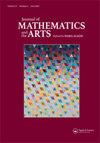Stixhexaknot: a symmetric cylinder arrangement of knotted glass
IF 0.2
Q4 MATHEMATICS, INTERDISCIPLINARY APPLICATIONS
引用次数: 1
Abstract
Diving deep into the patterns that make up the world is a fun way to reveal new perspectives. Paintings and sculptures create an opportunity where I can freely experiment and explore the universe. Mathematics provides an infinite realm of inspiration and helps give structure to my research. Abstraction expands on reality and presents a chance to look outside of a regular pattern of seeing. Playing with art and math often leads to unexpected questions and discoveries. For the past several years, I have been developing sculptures with symmetric arrangements of congruent cylinder packings restricted to only three and four directions. Hexastix and Tetrastix are periodic non-intersecting arrangements of cylinder packings that are of particular interest to me. Packing problems are an important class of optimization problems that have a visually rich history in mathematics. These homogeneous rod packings have been described by Conway in The symmetries of things (Conway, Burguel, & Goodman-Strauss, 2008) and by O’Keeffe in The invariant cubic rod packings (O’Keeffe, Plevert, Teshima,Watanabe, & Ogama, 2001). The structures described can be built easily with a little patience and present fairly stable configurations that naturally have some rigidity when compressed. Finite groupings of these cylinder packings can be joined in various ways to produce some interesting nets, helices, and polyhedrons. The large variety of options for the shape, configuration, and colouration of these structures provides ample space for artistic creativity. Finding ways to classify and develop new cylinder arrangements starts with sketching patterns of intersecting hexagonal prisms on paper. After some basic symmetry is worked out, I build a small series of models using an inexpensive material, mainly toothpicks or pencils. I develop the most appealing of these models further with diagrams that symmetrically connect the ends of the rods to create knots. Themodels and diagrams are then used to guide the creation of larger sculptures made out of glass. Straight, clear rods of borosilicate glass are cut to shorter segments before being organized using clamps and string to replicate themodel’s geometry. I use a propane andoxygen torch to melt the ends together in an orderly way. Using a flame that is over 2000 degrees打结玻璃:一种对称的圆柱体排列
深入研究构成世界的模式是一种揭示新视角的有趣方式。绘画和雕塑为我提供了一个自由实验和探索宇宙的机会。数学提供了无限的灵感,并帮助我的研究结构。抽象扩展了现实,并提供了一个在常规模式之外观察的机会。玩艺术和数学常常会带来意想不到的问题和发现。在过去的几年里,我一直在发展雕塑与对称排列一致的圆柱体包装限制只有三个和四个方向。Hexastix和Tetrastix是我特别感兴趣的圆柱体填料的周期性非相交安排。包装问题是一类重要的优化问题,在数学中有着丰富的历史。Conway在《事物的对称性》(Conway, Burguel, & Goodman-Strauss, 2008)和O 'Keeffe在《不变立方棒填料》(O 'Keeffe, Plevert, Teshima,Watanabe, & Ogama, 2001)中描述了这些均匀棒填料。所描述的结构可以很容易地建立与一点耐心,并呈现相当稳定的配置,自然有一些刚性压缩时。这些圆柱填料的有限组可以以各种方式连接在一起,产生一些有趣的网、螺旋和多面体。这些结构的形状、配置和颜色有多种选择,为艺术创造力提供了充足的空间。寻找分类和发展新的圆柱体排列的方法始于在纸上勾画相交的六边形棱镜的图案。在确定了一些基本的对称性之后,我用一种廉价的材料,主要是牙签或铅笔,制作了一系列的模型。我进一步开发了这些模型中最吸引人的图形,对称地连接杆的两端以创建结。然后,这些模型和图表被用来指导更大的玻璃雕塑的创作。直的,明确的棒硼硅酸盐玻璃被切割成较短的部分,然后使用夹具和字符串组织复制模型的几何形状。我用丙烷和氧气炬将两端有序地熔化在一起。使用超过2000度的火焰
本文章由计算机程序翻译,如有差异,请以英文原文为准。
求助全文
约1分钟内获得全文
求助全文
来源期刊

Journal of Mathematics and the Arts
MATHEMATICS, INTERDISCIPLINARY APPLICATIONS-
CiteScore
0.50
自引率
0.00%
发文量
19
 求助内容:
求助内容: 应助结果提醒方式:
应助结果提醒方式:


